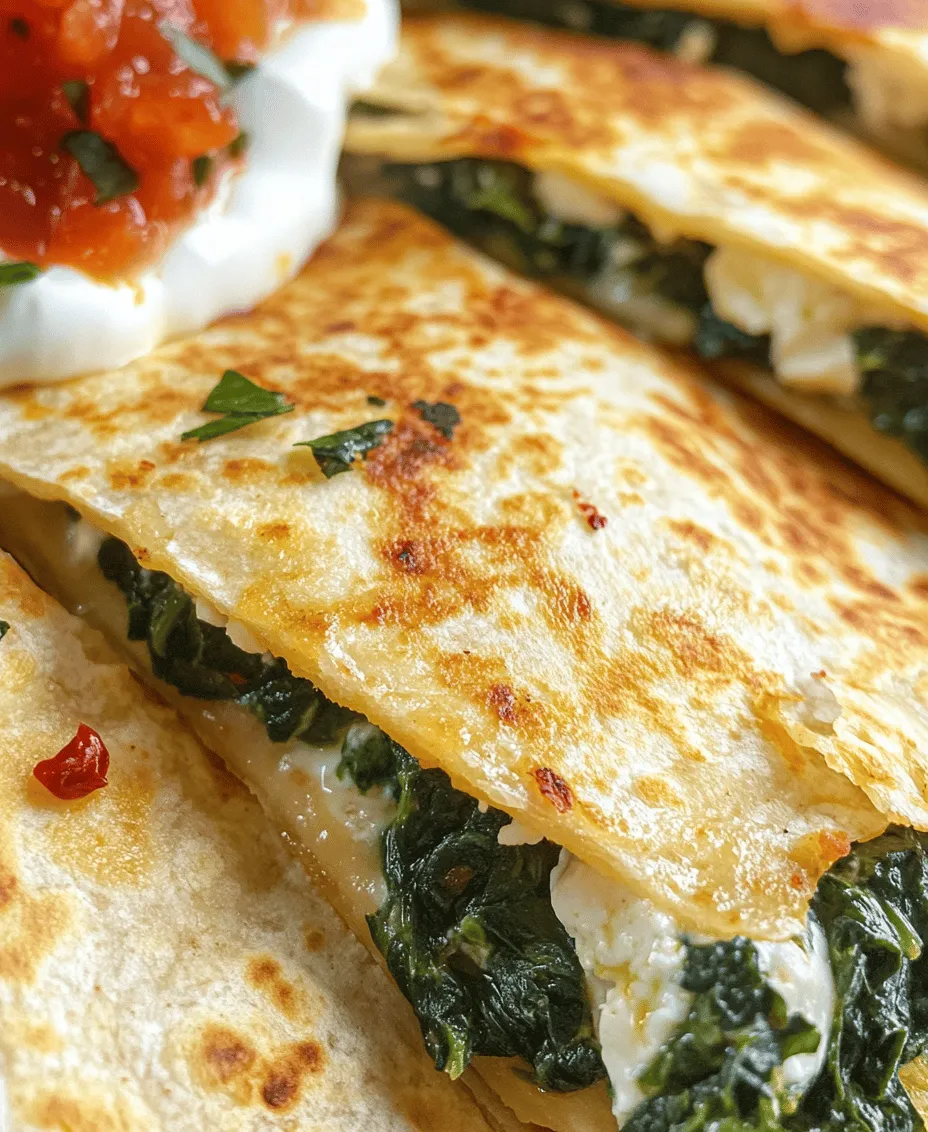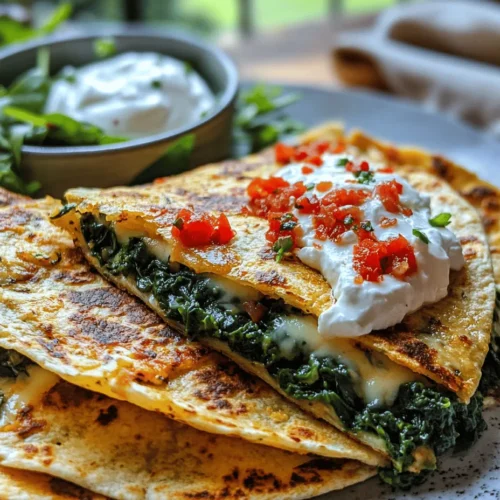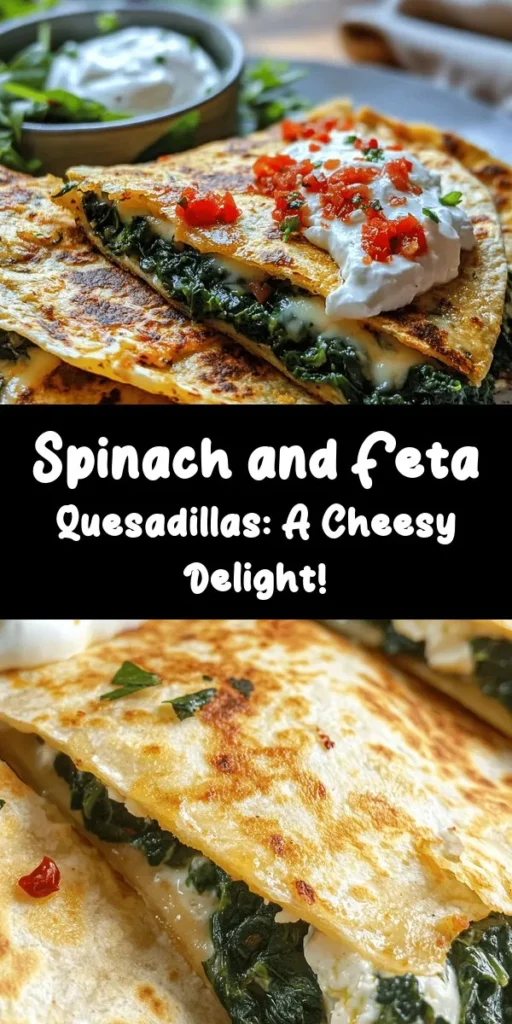Introduction
Quesadillas have long been celebrated as a versatile dish in Mexican cuisine, cherished for their simplicity and adaptability. These delightful creations consist of a tortilla filled with a variety of ingredients, folded in half, and cooked until crispy and golden. Whether enjoyed as a snack, a quick meal, or a party appetizer, quesadillas can cater to diverse tastes and dietary preferences. Among the numerous combinations available, spinach and feta quesadillas stand out for their unique flavor profile and health benefits. This recipe not only tantalizes your taste buds but also offers a nutritious twist that elevates the traditional quesadilla experience.
Combining the earthy and vibrant taste of fresh spinach with the creamy, tangy notes of feta cheese creates a harmonious blend that’s hard to resist. Spinach is known for its wealth of vitamins and minerals, while feta adds a delightful creaminess without overwhelming the dish. Together, they create a filling that is not only delicious but also packed with nutrients. Plus, these quesadillas are incredibly easy to prepare, making them an ideal option for busy weeknights, casual gatherings, or even as a quick lunch.
In this article, we’ll delve into the health benefits of spinach and feta, break down the essential ingredients needed for crafting these mouthwatering quesadillas, and guide you through the steps to create this delightful dish. So, let’s get started!
The Health Benefits of Spinach and Feta
Before we dive into the recipe, it’s essential to understand why spinach and feta are such stellar choices for this quesadilla. Both ingredients offer numerous health benefits that make them not only tasty but also nutritious.
Nutritional Profile of Spinach
Spinach is often hailed as a superfood, and for good reason. This leafy green is loaded with a plethora of vitamins and minerals, including:
– Vitamin A: Important for vision and immune function.
– Vitamin K: Crucial for blood clotting and bone health.
– Vitamin C: An antioxidant that helps protect cells from damage and supports the immune system.
– Iron: Essential for transporting oxygen in the blood.
– Folate: Important for DNA synthesis and repair, making it especially vital during pregnancy.
In addition to these vitamins and minerals, spinach is rich in antioxidants, which help combat oxidative stress in the body. Including spinach in your diet may improve heart health, enhance bone density, and even support weight loss efforts due to its low calorie and high fiber content.
Benefits of Incorporating Feta Cheese
Feta cheese, a staple in Mediterranean cuisine, also brings several health advantages to the table. Unlike many other cheeses, feta is lower in fat and calories, making it a suitable option for those looking to enjoy cheese without too much guilt.
Some key benefits of feta cheese include:
– Calcium: Vital for strong bones and teeth, feta provides a good source of this essential mineral.
– Protein: Feta is a decent source of protein, which is important for muscle repair and overall bodily function.
– Probiotics: As a fermented cheese, feta can promote gut health by providing beneficial bacteria.
When combined, spinach and feta not only create a delicious filling but also contribute to a well-rounded meal that supports overall health.
Ingredients Breakdown
Now that we understand the health benefits of our star ingredients, let’s take a closer look at what you’ll need to make these scrumptious spinach and feta quesadillas.
Fresh Spinach
Fresh spinach is the cornerstone of this recipe. When selecting spinach, look for vibrant green leaves that are crisp and free from wilting or yellowing. There are several types of spinach you can use, such as:
– Savoy Spinach: Characterized by its crinkly leaves and robust flavor. It holds up well in cooking.
– Flat-Leaf Spinach: Commonly found in bags at grocery stores, it has a milder taste and is easy to clean and prepare.
– Baby Spinach: Tender and sweet, baby spinach is great for salads but also works well in cooked dishes.
Storage Tips: To keep your spinach fresh, store it in the crisper drawer of your refrigerator in a breathable bag. Wash and dry the leaves only before use to avoid spoilage.
Feta Cheese
Feta cheese is a crumbly and tangy cheese that pairs perfectly with spinach in these quesadillas. When choosing feta, consider these options:
– Traditional Feta: Made from sheep’s milk, this version has a rich flavor and a slightly grainy texture.
– Cow’s Milk Feta: Milder and creamier, this type is more commonly found in supermarkets.
– Goat Cheese Feta: Offers a distinct flavor that can add a unique twist to your quesadilla.
Sourcing Recommendations: Look for feta cheese in the refrigerated section of your grocery store. If possible, opt for feta stored in brine, as this helps to preserve its flavor and texture.
Mozzarella Cheese
To enhance the overall creaminess and melt-in-your-mouth texture of the quesadillas, we’ll also incorporate mozzarella cheese. This cheese is ideal because it melts beautifully, complementing the feta without overpowering it.
When selecting mozzarella, you can choose between:
– Fresh Mozzarella: Soft and creamy, it adds a delightful texture but has a shorter shelf life.
– Low-Moisture Mozzarella: This is the type commonly found in pre-packaged blocks or shredded forms, offering convenience and great melting properties.
Flour Tortillas
The base of your quesadilla is the tortilla, and you have several options to choose from:
– Regular Flour Tortillas: Soft and pliable, these tortillas are great for traditional quesadillas.
– Whole Wheat Tortillas: For a healthier option, whole wheat tortillas add fiber and nutrients.
– Gluten-Free Tortillas: If you or your guests have dietary restrictions, there are excellent gluten-free options available made from rice or almond flour.
Olive Oil
Olive oil plays a crucial role in sautéing our spinach and garlic. Not only does it help to cook the ingredients evenly, but it also adds a rich flavor.
Types and Health Benefits: Extra virgin olive oil is the best choice for cooking due to its high-quality flavor and health benefits, including anti-inflammatory properties and heart-healthy fats.
Garlic
Garlic is a flavor powerhouse that elevates the taste of our quesadillas. It adds a savory depth that perfectly complements the spinach and feta.
Flavor Enhancement: When sautéed, garlic becomes aromatic and sweet, enhancing the overall flavor profile of the dish.
Seasonings
To bring all the flavors together, we’ll need some basic seasonings:
– Salt and Pepper: Essential for enhancing the natural flavors of the ingredients.
– Red Pepper Flakes: Optional, but they add a delightful kick that balances the creaminess of the cheese.
Serving Suggestions
Once your spinach and feta quesadillas are ready, consider serving them with:
– Sour Cream: Adds a creamy tanginess that pairs well with the quesadilla.
– Salsa: Fresh salsa or a zesty salsa verde can brighten up the dish and add a refreshing contrast.
Step-by-Step Guide to Making Spinach and Feta Quesadillas
Now that we have all our ingredients ready, let’s dive into the cooking process! The first step in crafting the perfect spinach and feta quesadilla is sautéing the spinach and garlic, which is crucial for enhancing their flavors.
Sautéing Spinach and Garlic
Begin by heating a tablespoon of olive oil in a large skillet over medium heat. Once the oil is shimmering, add minced garlic. Sauté the garlic for about 30 seconds, or until it becomes fragrant but not browned—burnt garlic can impart a bitter flavor to your dish.
Next, add the fresh spinach to the skillet. It’s important to work in batches if your skillet is not large enough to hold all the spinach at once. As you add the spinach, use tongs or a spatula to toss it gently in the oil and garlic.
Importance of Sautéing: Sautéing spinach not only softens the leaves but also intensifies its flavor, making it more palatable in the quesadilla.
Tips for Achieving Perfectly Wilted Spinach: Aim to wilt the spinach for about 2-3 minutes, just until it reduces in volume and turns a vibrant green. Be careful not to overcook it, as this can lead to a soggy filling. Once wilted, remove the skillet from heat and let the mixture cool slightly before mixing in the crumbled feta cheese.
With your spinach and garlic sautéed to perfection, you’re well on your way to creating delicious spinach and feta quesadillas that are sure to impress. In the next section, we will explore how to assemble and cook the quesadillas, bringing this flavorful dish to life. Stay tuned!

Mixing the Cheese Filling
Creating a delightful cheese filling is the heart of any quesadilla, and the Spinach and Feta Quesadilla is no exception. To achieve a cohesive filling that melts beautifully, start by combining two main cheeses: crumbled feta and shredded mozzarella. The feta brings a salty, tangy flavor, while the mozzarella contributes to a creamy texture when melted.
In a mixing bowl, combine approximately one cup of crumbled feta cheese with one cup of shredded mozzarella. To enhance the filling’s flavor profile, add a generous handful of fresh spinach leaves, chopped finely. Spinach not only adds nutrition but also a vibrant color contrast that makes your quesadilla visually appealing.
For an extra kick, consider adjusting the heat with red pepper flakes. Start with a quarter teaspoon and mix it into the cheese filling. This subtle addition can elevate the flavors without overwhelming the palate. Remember, you can always add more if you prefer a spicier quesadilla, but it’s best to start conservatively.
Assembling the Quesadillas
Once your cheese filling is ready, it’s time to assemble the quesadillas. Begin by laying out your tortillas—flour tortillas are typically preferred for their flexibility, but corn tortillas can be used for a gluten-free option. Spread a generous amount of the cheese filling onto one half of the tortilla, leaving about half an inch from the edges to prevent spills during cooking.
To ensure even distribution, use a spatula or the back of a spoon to spread the filling evenly. This prevents clumps and ensures every bite is full of flavor. After adding the filling, carefully fold the tortilla in half, pressing down gently to seal it.
Best practices also include using a non-stick skillet for cooking. If you’re using a regular skillet, a light coating of oil can help prevent sticking. When laying the quesadilla in the skillet, be mindful to place it seam-side down. This positioning helps keep the filling contained as it cooks.
Cooking the Quesadillas
The cooking process is pivotal to achieving crispy tortillas and perfectly melted cheese. Preheat your skillet over medium heat. This setting is optimal for creating a golden-brown exterior without burning the tortilla. If your skillet gets too hot, the outside may brown before the cheese has a chance to melt.
Cook the quesadilla for about 3-5 minutes on one side. You can tell when it’s ready to flip by gently lifting the edge and checking for a golden color. Once it has reached this stage, use a spatula to flip the quesadilla carefully; you may need to press down slightly to help it cook evenly. Cook for an additional 2-3 minutes on the other side until the cheese is thoroughly melted and the tortilla is crispy.
If you’re making multiple quesadillas, consider cooking them in batches. Keep the finished quesadillas warm in a preheated oven set to low heat (around 200°F) while you finish cooking the rest. This way, they’ll stay warm and the cheese will remain melty.
Serving Suggestions
When it comes to serving your Spinach and Feta Quesadillas, presentation matters. Cut them into wedges, and arrange them on a platter. A sprinkle of fresh herbs, such as chopped parsley or cilantro, can add a pop of color.
Pair your quesadillas with a selection of dips and sides to enhance the dining experience. A simple homemade tzatziki sauce made from Greek yogurt, cucumber, garlic, and lemon juice complements the Mediterranean flavors beautifully. Additionally, consider serving with a side of fresh salsa or guacamole for a Mexican twist.
For those with dietary preferences, this recipe is easily customizable. To cater to vegetarian diets, simply ensure all ingredients are plant-based. If gluten is a concern, opt for corn tortillas or gluten-free tortillas, which are widely available.
Variations on the Spinach and Feta Quesadilla
While the classic Spinach and Feta Quesadilla is undeniably delicious, there are numerous ways to customize it to suit your taste. For a heartier filling, consider adding other vegetables such as bell peppers, mushrooms, or even sautéed onions. These additions not only enhance the flavor but also add variety to the texture.
You can also experiment with different cheeses. Substituting goat cheese for feta can create a creamier filling with a distinct tang. Alternatively, mixing in pepper jack or cheddar can introduce new flavor dimensions to the dish.
For those looking to include protein, grilled chicken, shrimp, or black beans can be wonderful additions, making the quesadilla more filling and satisfying. This flexibility allows you to cater to different palates and dietary needs.
Additionally, think about adapting the quesadilla to reflect different culinary influences. For a Mediterranean twist, consider adding olives or sun-dried tomatoes. To create a Mexican fusion experience, include some black beans and corn, and serve with a side of pico de gallo.
Conclusion
Spinach and Feta Quesadillas are a versatile dish that combines simplicity with flavor, making them perfect for various occasions—from casual snacks to elegant appetizers. The ease of preparation, paired with the ability to customize ingredients, ensures that this recipe can become a staple in your cooking repertoire.
Encourage your friends and family to experiment with personal variations, whether they prefer extra spice or additional vegetables. With this recipe, the delightful flavors of spinach and feta come together beautifully, offering a delicious and satisfying meal that everyone will enjoy. So gather your ingredients, unleash your creativity, and relish the deliciousness of homemade quesadillas that are sure to impress!



